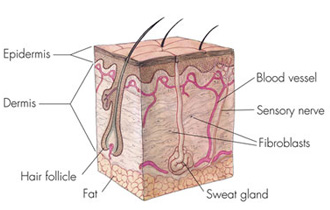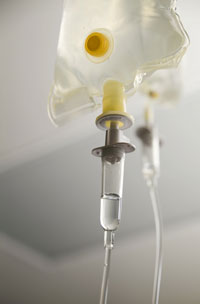What is a burn?
A burn is tissue damage caused by heat, chemicals, electricity, sunlight or nuclear radiation. The most common burns are those caused by scalds, building fires and flammable liquids and gases.
- First-degree burns affect only the outer layer (the epidermis) of the skin.
- Second-degree burns damage the epidermis and the layer beneath it (the dermis).
- Third-degree burns involve damage or complete destruction of the skin to its full depth and damage to underlying tissues.

How does the body react to a severe burn?
The swelling and blistering characteristic of burns is caused by the loss of fluid from damaged blood vessels. In severe cases, such fluid loss can cause shock. Burns often lead to infection, due to damage to the skin's protective barrier.
How are burns treated?
In many cases, topical antibiotics (skin creams or ointments) are used to prevent infection. For third-degree burns and some second-degree ones, immediate blood transfusion and/or extra fluids are needed to maintain blood pressure. Grafting with natural or artificial materials speeds the post-burn healing process.
What is skin grafting?
There are two types of skin grafts. An autologous skin graft transfers skin from one part of the body to another while an allograft transfers skin from another person, sometimes even a cadaver. Scientists typically take cells from the epidermal layer of skin and then grow them into large sheets of cells in the laboratory. They do not yet know how to grow the lower, dermal layer of skin in the lab. For this reason, surgeons, after removing burned skin, first cover the area with an artificial material and then add the cell sheets on top. This procedure helps encourage the growth of new skin
What is the prognosis for severe burn victims?
A few decades ago, burns covering half the body were often fatal. Now, thanks to research, many people with burns covering 90 percent of their bodies can survive, although they often have permanent impairments and scars.

Where are people treated for burns?
Over half of burn patients in the United States are treated in specialized burn centers, and most hospitals have trauma teams that care exclusively for patients with traumatic injuries that may accompany burns.
How has basic research improved burn care?
Remarkable improvements in burn care have resulted from basic research funded by the National Institutes of Health. The results have led to the best approaches for fluid resuscitation, wound cleaning, skin replacement, infection control and nutritional support.
What is on the horizon for burn research?
Improving methods for wound healing and tissue repair offer tremendous opportunities to enhance the quality of life for burn patients and may also help to reduce health care costs.
What kinds of burn research does the National Institute of General Medical Sciences (NIGMS) support?
NIGMS funds research that explores clinical issues involving whole-body responses to burns, and various aspects of the recovery process, such as wound healing and tissue repair. An important goal of this research is to apply basic knowledge to reducing or even preventing complications after injury. NIGMS also supports research on established clinical practices that, in many cases, have arisen as a result of anecdotal evidence rather than rigorous, hypothesis-driven testing.
Where can I find more information about burns?
- The Alisa Ann Ruch Burn Foundation
 is a nonprofit health organization dedicated to burn prevention and survivor assistance.
is a nonprofit health organization dedicated to burn prevention and survivor assistance. - The American Burn Association
 is a nonprofit health association dedicated to addressing the problems of burn injuries and burn survivors throughout the United States, Canada and other countries.
is a nonprofit health association dedicated to addressing the problems of burn injuries and burn survivors throughout the United States, Canada and other countries. - Burn Survivor.org
 is a nonprofit organization focused on education, prevention and the non-medical and emotional issues related to burn care.
is a nonprofit organization focused on education, prevention and the non-medical and emotional issues related to burn care. - MEDLINEplus Health Topics: Burns is an NIH National Library of Medicine Web site containing information and links about burns and burn research.
- The Phoenix Society for Burn Survivors
 is an international, nonprofit organization helping burn survivors and their families.
is an international, nonprofit organization helping burn survivors and their families. - Shriners Hospitals for Children
 is a nationwide network of hospitals that provide no-cost orthopedic and burn care to children under 18 years of age, regardless of financial need.
is a nationwide network of hospitals that provide no-cost orthopedic and burn care to children under 18 years of age, regardless of financial need. - World Burn Foundation
 is an online resource providing information and support for burn survivors and family members.
is an online resource providing information and support for burn survivors and family members.
NIGMS is a part of the National Institutes of Health that supports basic research to increase our understanding of life processes and lay the foundation for advances in disease diagnosis, treatment and prevention. For more information on the Institute's research and training programs, see http://www.nigms.nih.gov.
Content reviewed November 2012